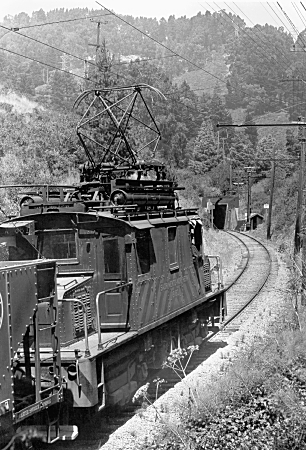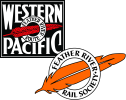SN OPERATING RULES THROUGH THE OAKLAND HILLS
The Pacific Gas & Electric Company charged the Sacramento Northern in 20 minute increments for power fed through the Eastport substation. This substation had two 1000 horsepower motor generator sets due to the heavy grades east, and especially west, of that location. Power use at the substation could be quite heavy as freight trains worked their way up the grades and through the Redwood Peak Tunnel.
To avoid higher electricity charges, the SN instituted power waits in the post-war years. The rules for power waits are found in EMPLOYEE TIMETABLE 25 of September 27, 1953. Power waits are not mentioned in ETT 23 of April 20, 1947. Other timetables were not available for your author to determine when these policies began or ended.
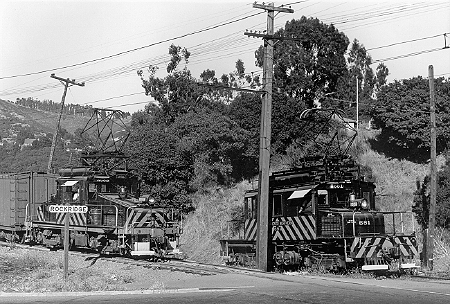
During a power wait, pantographs were lowered and the locomotives completely shut down. It was cheaper to pay a crew to do nothing than to exceed the power allocation. No power waits were required during the off-peak hours between 11 p.m. and 6 a.m., or on Sundays and holidays.
On many electric freight locomotives and passenger cars, the motors on axles one and four were connected in series, as were the motors on axles two and three. This method of connecting armatures with fields is called "concatinated", or more commonly "cascade". When starting a concatinated locomotive or passenger car, all motors are operated in full-series across the first half of the controller. As speed increases, the motors act as generators. The "back pressure" of the current created by the motors rises to equal that being taken from the wire, limiting maximum speed. When the engineer notches the controller into the second half, shunt switches reroute the current so the motor pairs now run in series-parallel, lowering the "back pressure". Full-series gives maximum power for starting a car or locomotive, and series-parallel gives less resistance when operating speed is reached.
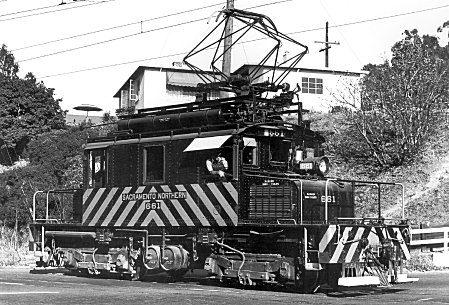
Engines 643 and 644 (former 603 and 604) were equipped with air brake transfer valves, plus full power and control connections. They could operated under full multiple-unit control by a single engineer, the only 1200/1500 volt SN locomotives so equipped (excepting box motors 601, 602 and 607, but they were gone by the time power wait rules were applied). When operating in multiple-unit control, the pantograph of the second locomotive was kept in the down position. Series-parallel control could be used when 643 and 644 worked together in situations where two other locomotives were required to run in full-series. This made 643 and 644 an exception to some of the complex rules noted below. If 643 and 644 headed a train with a third locomotive, the twins were considered two separate locomotives though still under the control of one engineer. In such a case, power wait rules for a three-locomotive combination governed.
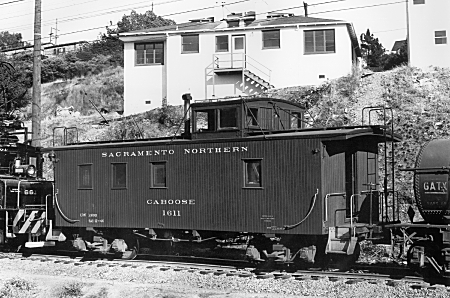
The picture was further complicated by 645 and 646 (former 605 and 606). Because they had passenger brakes, 645 and 646 were not mixed with the other locomotives on the front of a train, though they could operate together in the front, and could be used alone in the front, or as single rear-end helpers. Because they were geared for passenger speeds, these two locomotives were run in full-series to better match their speed with the freight-geared locomotives. [There is some doubt that 646 ever ran under this number, but may have already been in storage when the renumbering came in 1953.]
When three locomotives were coupled together, full-series was used, except when two of the locomotives were paired 643 and 644. The second helper worked only when needed to meet tonnage ratings for three-engine trains. This required close coordination between the engineers and conductors. Conductors were required to advise engineers of how many loads and empties were in the train, and the total number of trailing tons. Both conductors and engineers were held jointly responsible for compliance with all regulations in handling their trains, and for observing the power waits.
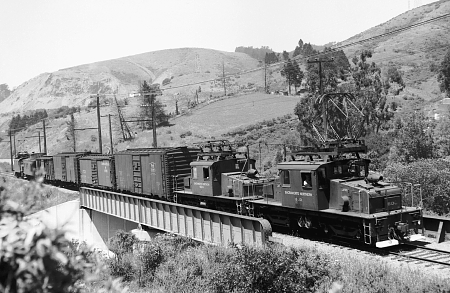
The regulations could become quite complex, depending on the weight of the train, and which locomotives were operated. On eastbound trains between College Avenue and Temescal, including the incredibly steep 4.6 percent grade between Rockridge and Temescal, trains of 200 tons or less were run with controllers in series-parallel position, excepting 645 and 646. On trains over 200 tons, all engines were run in full-series. No power waits were required.
From Temescal to the summit east of Havens with trains of 200 to 350 tons, all locomotives except 645 and 646 ran in series-parallel position with no power waits. On trains of 350 to 540 tons, full-series position was used, except with paired 643 and 644. At Temescal, a 15 minute power wait, or a wait until the even hour or half hour, was required. On trains over 540 tons, again excepting trains with paired 643 and 644, the full-series position was used. The Temescal wait was at least 15 minutes, with a departure allowed only between 15 and 20 minutes, or 45 and 50 minutes of the hour.
Between Lafayette and St. Mary's westbound trains with less than 500 tons were run with either full-series or series-parallel, depending on the locomotive and conditions. No power waits were required. Trains with between 500 and 650 tons were operated in full-series position, except behind paired 643 and 644, and again no power waits were required. When pulling over 650 tons, all locomotives were run in full-series position, except paired 643 and 644. In this case, a 15 minute power wait, or a wait until the even hour or half hour, was required at Burton.
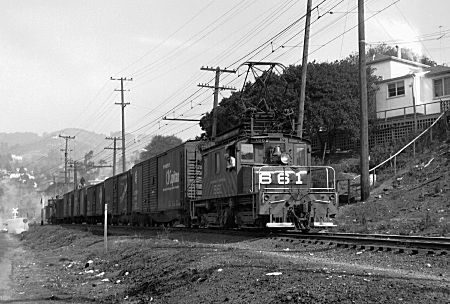
For operation between Moraga and Havens, all locomotives on trains up to 650 tons used full-series, except paired 643 and 644. No power waits were required. When pulling over 650 tons, all locomotives used full-series. A power wait at Moraga for not less than 15 minutes was required. Trains usually departed at between 15 and 20 minutes, or 45 and 50 minutes of the hour. It was also permissible to depart at any time after just a 15 minute wait, if another 15 minute wait, or a wait until the even hour or half hour, was taken at Pinehurst.
Additional power waits were built into meets between opposing freight trains. Eastbound trains were required to take a siding 20 minutes before the arrival of westbound trains, and to remain there for 20 minutes after passage of the westbound train. This type of power wait could happen at any siding.
Braking, especially on the 4.6 percent descending westbound grade, had a number of special requirements. Locomotives 653, 654, 660, 661 and 670 were equipped with transfer valves, but no power or control connections. When two of these locomotives ran coupled, two engineers were required, with the lead engineer controlling the train air brakes and with the pantographs up on both locomotives. At some time in the early 1950s, all these locomotives received power connections. This allowed all the air compressors to work together under the control of the lead engineer, and only the lead locomotive kept its pantograph up, in effect making the second locomotive a braking sled on the descending grade. After electric operations at Sacramento ended in 1953, locomotive 652 came south to work out of Oakland. This locomotive had transfer valves, but was never fitted with power connections, and would have its pantograph raised at all times.
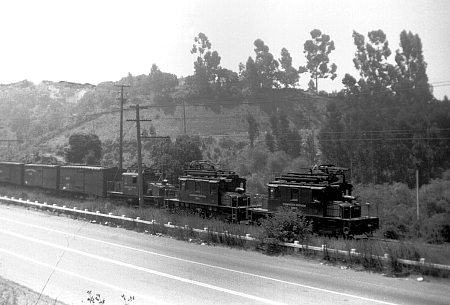
The descending grade between Havens and Rockridge had strict limits on how many cars were allowed behind various locomotives. Trains were were limited to 15 cars if operated with only one locomotive, or 25 cars with two. Due to their passenger brakes, locomotives 645 and 646 were restricted to 10 cars alone, or 20 cars when paired. All compressors were required to be working on paired locomotives if 25 cars were handled. If only three compressors were operating, the limit dropped to 18 cars. With paired 645 and 646, three working compressors dropped the limit to 15 cars. On single locomotives, both compressors were required to be working. Service applications of the air brakes were made in short cycles, rather than less frequent heavy applications, to avoid excessive reduction of the train line pressure. Engineers used the independent air brakes on the locomotives to hold the train in check while the train air line recharged.
Cars were required to have all air brakes in working order, and total tonnage was not to exceed 55 tons per operative brake. On loaded cars, the retaining valves were set in the high-pressure position. On empty cars, the retainers were placed in the low-pressure position. The low pressure pressure position was also allowed on SN boxcars in merchandise service, which were very lightly loaded. Any cars with non-working brakes, whether from air brake failure, or broken rigging, were required to be set out for repairs.
